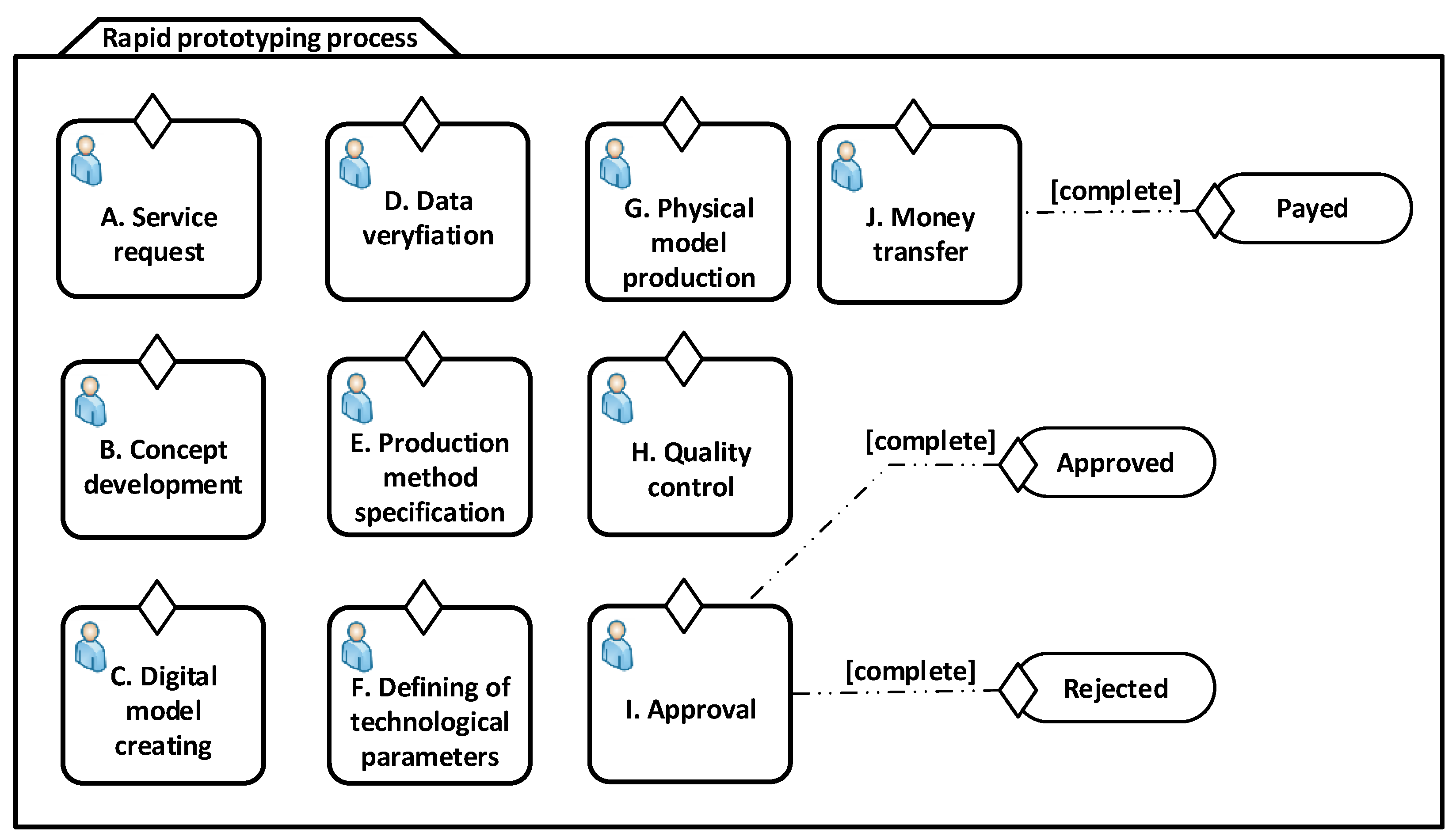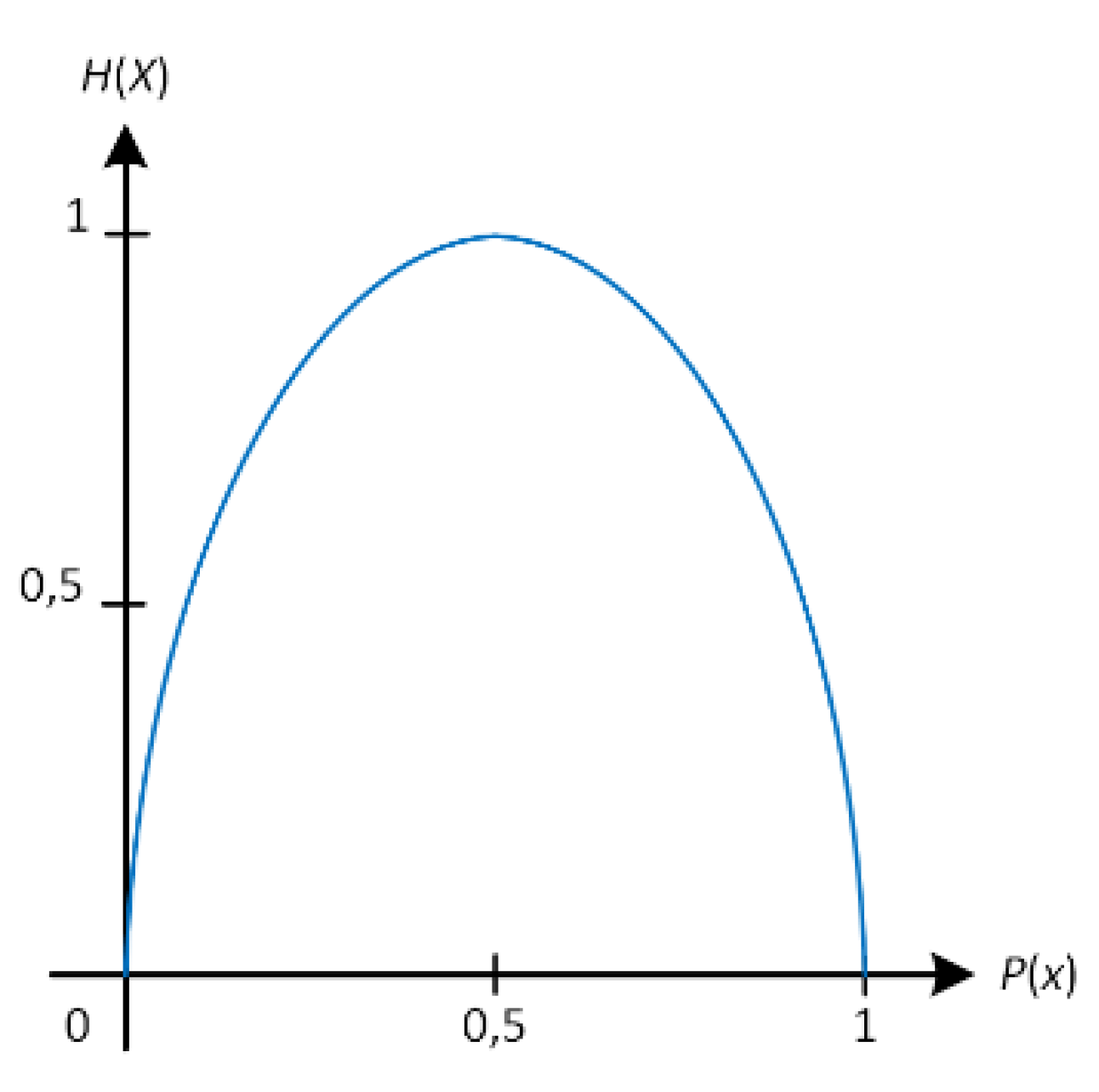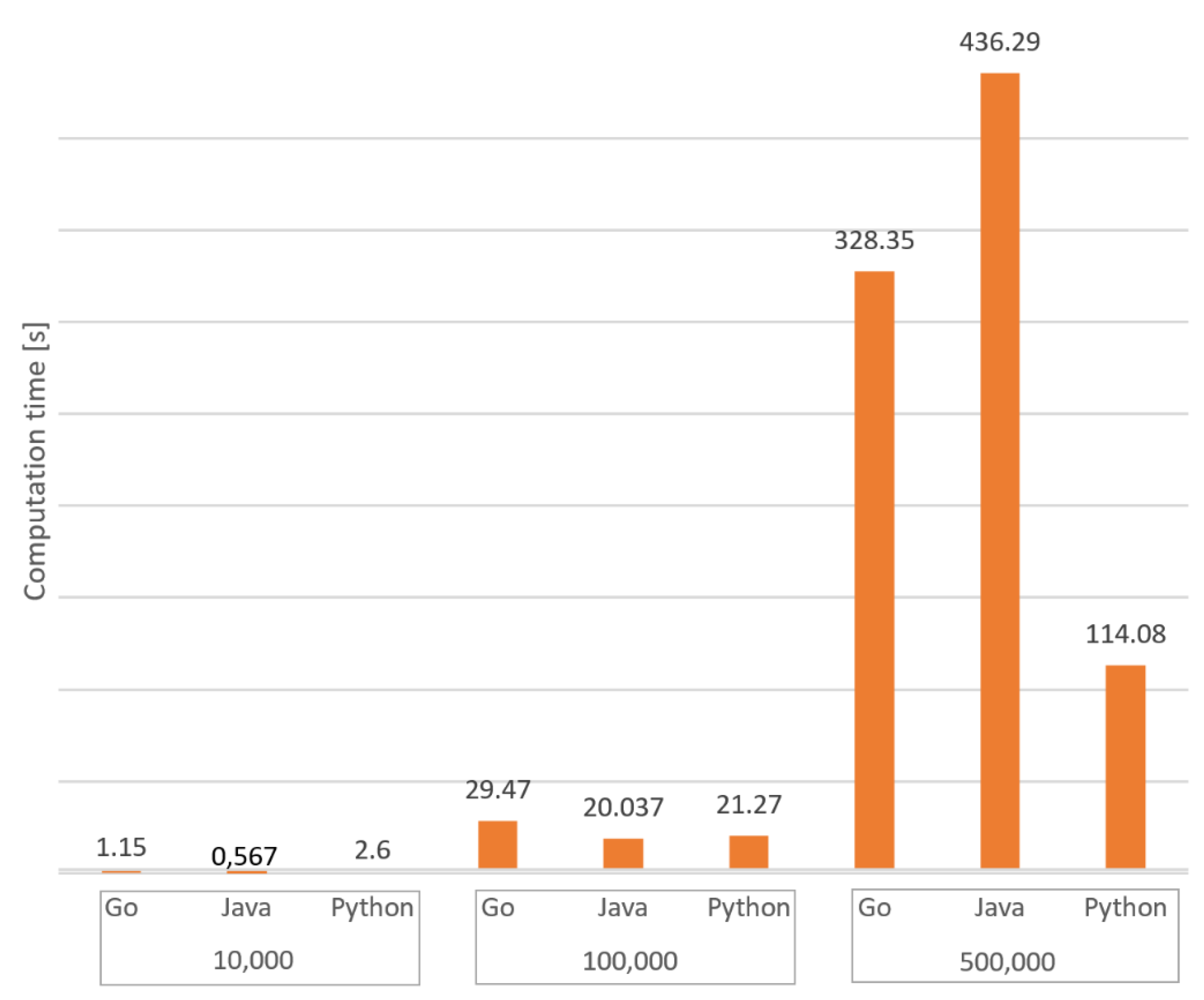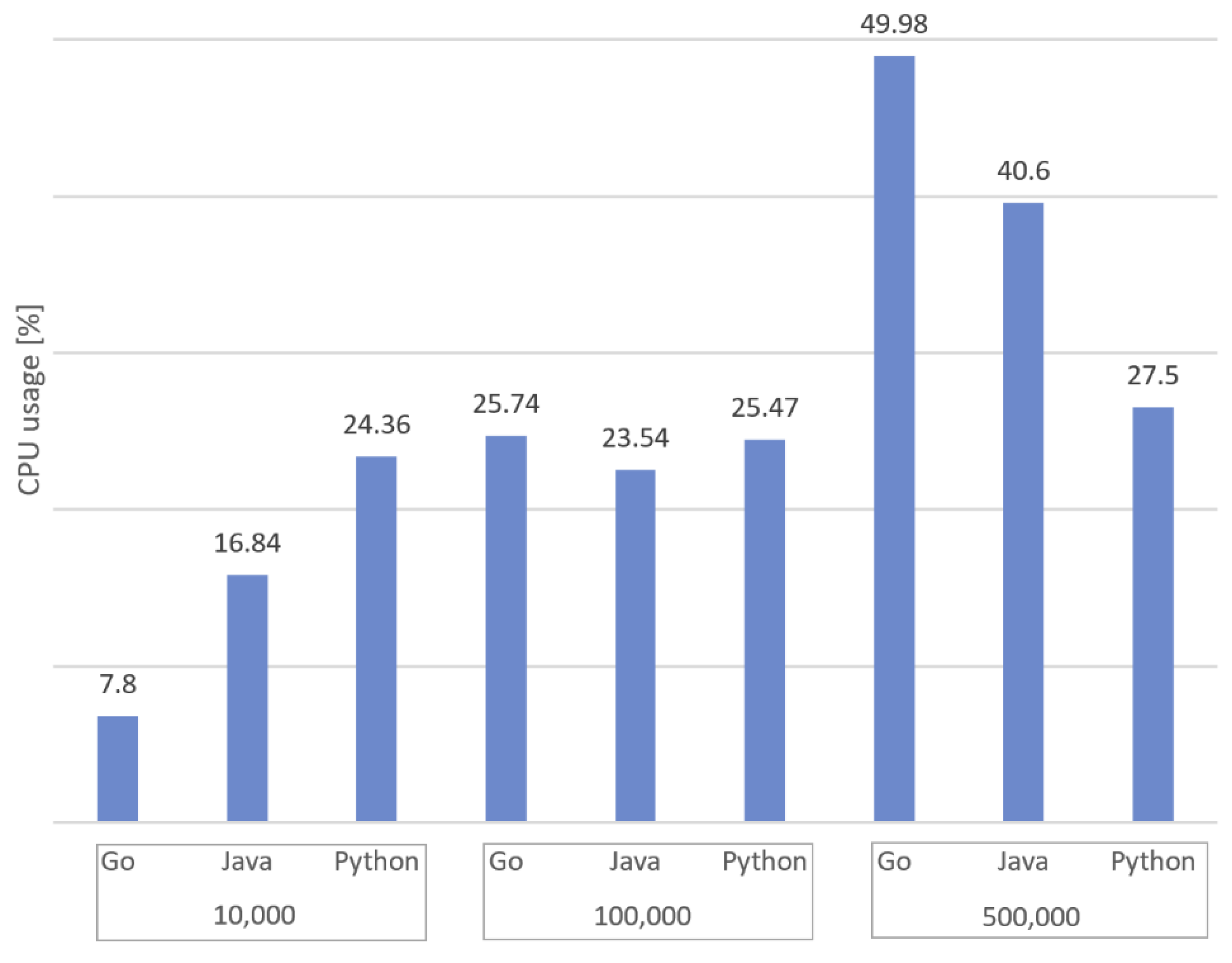Performance Analysis of Selected Programming Languages in the Context of Supporting Decision-Making Processes for Industry 4.0
Abstract
:1. Introduction
2. Previous Works
3. Implementation of the Decision Tree Algorithm
| Algorithm 1. Decision Tree Algorithm. | |
| Input: An attribute-valued dataset Output: Decision tree | |
| 1: | |
| 2: | Start at the root node |
| 3: | Calculate the entropy of the whole data set |
| 4: | For each attribute : |
| 5: | - divide input data into subsets |
| 6: | - calculate the entropy for each subset |
| 7: | - select these attributes for which the entropy variation is the highest. This entropy variation is measured by IG (Information Gain) |
| 8: | - group data along selected branches |
| 9: | - find attributes to dividing the data set in the nodes of the next level |
| 10: | - set the decision in the node |
| 11: | End For |
| 12: | If a stopping criterion is reached Then |
| 13: | Return decision tree |
| 14: | Otherwise, terminate. |
Measures Used in Decision Trees
4. Results of the Research Work
5. Conclusions
Author Contributions
Funding
Conflicts of Interest
References
- Godina, R.; Ribeiro, I.; Matos, F.; Ferreira, B.T.; Carvalho, H.; Peças, P. Impact Assessment of Additive Manufacturing on Sustainable Business Models in Industry 4.0 Context. Sustainability 2020, 12, 7066. [Google Scholar] [CrossRef]
- Pereira, A.C.; Romero, F. A review of the meanings and the implications of the Industry 4.0 concept. Procedia Manuf. 2017, 13, 1206–1214. [Google Scholar] [CrossRef]
- Strange, R.; Zucchella, A. Industry 4.0, global value chains and international business. Multinatl. Bus. Rev. 2017, 25, 174–184. [Google Scholar] [CrossRef]
- Barosz, P.; Gołda, G.; Kampa, A. Efficiency Analysis of Manufacturing Line with Industrial Robots and Human Operators. Appl. Sci. 2020, 10, 2862. [Google Scholar] [CrossRef] [Green Version]
- Tsafnat, G.; Glasziou, P.; Choong, M.K.; Dunn, A.; Galgani, F.; Coiera, E. Systematic review automation technologies. Syst. Rev. 2014, 3, 74. [Google Scholar] [CrossRef] [Green Version]
- Kusiak, A. Smart manufacturing. Int. J. Prod. Res. 2018, 56, 508–517. [Google Scholar] [CrossRef]
- Schumacher, A.; Nemeth, T.; Sihn, W. Roadmapping towards industrial digitalization based on an Industry 4.0 maturity model for manufacturing enterprises. In Proceedings of the 12th CIRP Conference on Intelligent Computation in Manufacturing Engineering, CIRP ICME, Gulf of Naples, Italy, 18–20 July 2018; pp. 409–414. [Google Scholar]
- Zhou, J. Digitalization and intelligentization of manufacturing industry. Adv. Manuf. 2013, 1, 1–7. [Google Scholar] [CrossRef] [Green Version]
- Sjödin, D.R.; Parida, V.; Leksell, M.; Petrovic, A. Smart Factory Implementation and Process Innovation. Res. Technol. Manag. 2018, 61, 22–31. [Google Scholar] [CrossRef] [Green Version]
- Rojko, A. Industry 4.0 Concept: Background and Overview. Int. J. Interact. Mobile Technol. 2017, 11, 77–89. [Google Scholar] [CrossRef] [Green Version]
- Saucedo-Martínez, J.A.; Pérez-Lara, M.; Marmolejo-Saucedo, J.A.; Salais-Fierro, T.E.; Vasant, P. Industry 4.0 framework for management and operations: A review. J. Ambient Intell. Humaniz. Comput. Vol. 2018, 9, 789–801. [Google Scholar] [CrossRef]
- Mazur, D.; Paszkiewicz, A.; Bolanowski, M.; Budzik, G.; Oleksy, M. Analysis of possible SDN use in the rapid prototyping process as part of the Industry 4.0. Bull. Pol. Acad. Sci. Tech. Sci. 2019, 67, 21–30. [Google Scholar]
- Haseeb, M.; Hussain, H.I.; Ślusarczyk, B.; Jermsittiparsert, K. Industry 4.0: A Solution towards Technology Challenges of Sustainable Business Performance. Soc. Sci. 2019, 8, 154. [Google Scholar] [CrossRef] [Green Version]
- Piccarozzi, M.; Aquilani, B.; Gatti, C. Industry 4.0 in Management Studies: A Systematic Literature Review. Sustainability 2018, 10, 3821. [Google Scholar] [CrossRef] [Green Version]
- Aslam, F.; Aimin, W.; Li, M.; Ur Rehman, K. Innovation in the Era of IoT and Industry 5.0: Absolute Innovation Management (AIM) Framework. Information 2020, 11, 124. [Google Scholar] [CrossRef] [Green Version]
- Hecklau, F.; Galeitzke, M.; Flachs, S.; Kohl, H. Holistic approach for human resource management in Industry 4.0. Procedia CIRP 2016, 54, 1–6. [Google Scholar] [CrossRef]
- Xu, L.D.; Duan, L. Big data for cyber physical systems in industry 4.0: A survey. Enterp. Inf. Syst. 2019, 13, 148–169. [Google Scholar] [CrossRef]
- Yan, J.; Meng, Y.; Lu, L.; Li, L. Industrial Big Data in an Industry 4.0 Environment: Challenges, Schemes, and Applications for Predictive Maintenance. IEEE Access 2017, 5, 23484–23491. [Google Scholar] [CrossRef]
- Mourtzis, D.; Vlachou, E.; Milas, N. Industrial Big Data as a Result of IoT Adoption in Manufacturing. Procedia CIRP 2016, 55, 290–295. [Google Scholar] [CrossRef] [Green Version]
- Trstenjak, M.; Cosic, P. Process Planning in Industry 4.0 Environment. Procedia Manuf. 2017, 11, 1744–1750. [Google Scholar] [CrossRef] [Green Version]
- Paszkiewicz, A.; Bolanowski, M.; Budzik, G.; Przeszłowski, Ł.; Oleksy, M. Process of Creating an Integrated Design and Manufacturing Environment as Part of the Structure of Industry 4.0. Processes 2020, 8, 1019. [Google Scholar] [CrossRef]
- Dymora, P.; Mazurek, M.; Mroczka, B. Code optimization of advanced applications on the example of selected development technologies. In VII Konferencja Naukowa “Symbioza Techniki i Informatyki”; Wydawnictwo Uniwersytetu Rzeszowskiego: Rzeszów, Poland, 2017. [Google Scholar]
- Li, Y.; Fu, Y.; Tang, X.; Hu, X. Optimizing the Reliability and Efficiency for an Assembly Line That Considers Uncertain Task Time Attributes. IEEE Access 2019, 7, 34121–34130. [Google Scholar] [CrossRef]
- Semeria, L.; Ghosh, A. Methodology for hardware/software co-verification in C/C++. In Proceedings 2000. Design Automation Conference, Yokohama, Japan; IEEE Cat. No.00CH37106; IEEE: Piscataway, NJ, USA, 2000; pp. 405–408. [Google Scholar] [CrossRef] [Green Version]
- Myalapalli, V.K.; Geloth, S. Minimizing impact on JAVA virtual machine via JAVA code optimization. In 2015 International Conference on Energy Systems and Applications; IEEE: Piscataway, NJ, USA, 2015; pp. 19–24. [Google Scholar]
- Dymora, P.; Mazurek, M.; Maciąg, P. Implementation and analysis of self-reconfigurable routing protocol for wireless sensor networks. In VII Konferencja Naukowa “Symbioza Techniki i Infromatyki”; Wydawnictwo Uniwersytetu Rzeszowskiego: Rzeszów, Poland, 2017. [Google Scholar]
- Liang, M.; Wang, X. The design of intelligent robot based on embedded system. In Proceedings of the 2011 International Conference on Advanced Mechatronic Systems, Zhengzhou, China, 11 August 2011; IEEE: Piscataway, NJ, USA, 2011; pp. 23–28. [Google Scholar]
- Al Hayajneh, A.; Bhuiyan, M.Z.A.; McAndrew, I. Improving Internet of Things (IoT) Security with Software-Defined Networking (SDN). Computers 2020, 9, 8. [Google Scholar] [CrossRef] [Green Version]
- Kiran, M.; Pouyoul, E.; Mercian, A.; Tierney, B.; Guok, C.; Monga, I. Enabling intent to configure scientific networks for high performance demands. Future Gener. Comput. Syst. 2018, 79, 205–214. [Google Scholar] [CrossRef] [Green Version]
- Foster, N.; Harrison, R.; Freedman, M.J.; Monsanto, C.; Rexford, J.; Story, A.; Walker, D. Frenetic: A network programming language. ACM Sigplan Not. 2011, 46, 279–291. [Google Scholar] [CrossRef]
- Voellmy, A.; Kim, H.; Feamster, N. Procera: A language for high-level reactive network control. In Proceedings of the 1st Workshop Hot Topics Software Defined Networks, Helsinki, Finland, 13 August 2012; Association for Computing Machinery: New York, NY, USA, 2012; pp. 43–48. [Google Scholar]
- Wang, J.; Cheng, S.; Fu, X. SDN Programming for Heterogeneous Switches with Flow Table Pipelining. Sci. Program. 2018, 2018, 2848232. [Google Scholar] [CrossRef]
- Wang, X.; Tian, Y.; Zhao, M.; Li, M.; Mei, L.; Zhang, X. PNPL: Simplifying programming for protocol-oblivious SDN networks. Comput. Netw. 2018, 147, 64–80. [Google Scholar] [CrossRef]
- Lehmhus, D.; Wuest, T.; Wellsandt, S.; Bosse, S.; Kaihara, T.; Thoben, K.-D.; Busse, M. Cloud-Based Automated Design and Additive Manufacturing: A Usage Data-Enabled Paradigm Shift. Sensors 2015, 15, 32079–32122. [Google Scholar] [CrossRef] [Green Version]
- Zhang, Y.; Zhang, G.; Liu, Y.; Hu, D. Research on services encapsulation and virtualization access model of machine for cloud manufacturing. J. Intell. Manuf. 2017, 28, 1109–1123. [Google Scholar] [CrossRef]
- Howard, R.; Björk, B.-C. Use of standards for CAD layers in building. Autom. Constr. 2007, 16, 290–297. [Google Scholar] [CrossRef] [Green Version]
- Kim, D.B.; Shin, S.-J.; Shao, G.; Brodsky, A. A decision-guidance framework for sustainability performance analysis of manufacturing processes. Int. J. Adv. Manuf. Technol. 2015, 78, 1455–1471. [Google Scholar] [CrossRef]
- Bruccoleri, M.; La Diega, S.N.; Perrone, G. An Object-Oriented Approach for Flexible Manufacturing Control Systems Analysis and Design Using the Unified Modeling Language. Int. J. Flex. Manuf. Syst. 2003, 15, 195–216. [Google Scholar] [CrossRef]
- Morel, G.; Panetto, H.; Zaremba, M.; Mayer, F. Manufacturing Enterprise Control and Management System Engineering: Paradigms and open issues. Annu. Rev. Control 2003, 27, 199–209. [Google Scholar] [CrossRef] [Green Version]
- Ward, T.L.; Ralston, P.A.S.; Davis, J.A. Fuzzy logic control of aggregate production planning. Comput. Ind. Eng. 1992, 23, 137–140. [Google Scholar] [CrossRef]
- Noorul Haq, A.; Kannan, G. Design of an integrated supplier selection and multi-echelon distribution inventory model in a built-to-order supply chain environment. Int. J. Prod. Res. 2006, 44, 1963–1985. [Google Scholar] [CrossRef]
- Wang, S.; Wan, J.; Li, D.; Liu, C. Knowledge Reasoning with Semantic Data for Real-Time Data Processing in Smart Factory. Sensors 2018, 18, 471. [Google Scholar] [CrossRef] [Green Version]
- Idris, I. Python Data Analysis, 2nd ed.; Packt Publishing: Birmingham, UK, 2014. [Google Scholar]
- Dymora, P.; Mazurek, M. Performance Assessment of Selected Techniques and Methods Detecting Duplicates in Data Warehouses, Theory and Applications of Dependable Computer Systems. DepCoS-RELCOMEX 2020. In Advances in Intelligent Systems and Computing; Springer: Cham, Switzerland, 2020; Volume 1173. [Google Scholar] [CrossRef]
- Dymora, P.; Mazurek, M.; Łannik, D. Badanie efektywności tworzenia wielowymiarowych zestawów danych w wybranych środowiskach analitycznych, Monografia pt. In Social and Technical Aspects of Security; Oficyna Wydawnicza Politechniki Rzeszowskiej: Rzeszów, Poland, 2019; pp. 37–57. ISBN 978-83-7934-352-2. [Google Scholar]
- Mabkhot, M.M.; Al-Ahmari, A.M.; Salah, B.; Alkhalefah, H. Requirements of the Smart Factory System: A Survey and Perspective. Machines 2018, 6, 23. [Google Scholar] [CrossRef] [Green Version]
- Jaskó, S.; Skrop, A.; Holczinger, T.; Chován, T.; Abonyi, J. Development of manufacturing execution systems in accordance with Industry 4.0 requirements: A review of standard- and ontology-based methodologies and tools. Comput. Ind. 2020, 123, 103300. [Google Scholar]
- Bansal, A.K. Introduction to Programming Languages; CRC Press: Boca Raton, FL, USA, 2013. [Google Scholar]
- Ajah, I.A.; Nweke, H.F. Big Data and Business Analytics: Trends, Platforms, Success Factors and Applications. Big Data Cogn. Comput. 2019, 3, 32. [Google Scholar] [CrossRef] [Green Version]
- Esquembre, F. Easy Java Simulations: A software tool to create scientific simulations in Java. Comput. Phys. Commun. 2004, 156, 199–204. [Google Scholar] [CrossRef]
- Boisvert, R.F.; Moreira, J.; Philippsen, M.; Pozo, R. Java and numerical computing. Comput. Sci. Eng. 2001, 3, 18–24. [Google Scholar] [CrossRef] [Green Version]
- The 10 Most Popular Programming Languages to Learn in 2020. Available online: https://www.northeastern.edu/graduate/blog/most-popular-programming-languages/ (accessed on 10 September 2020).
- Hao, J.; Ho, T.K. Machine Learning Made Easy: A Review of Scikit-learn Package in Python Programming Language. J. Educ. Behav. Stat. 2019, 44, 348–361. [Google Scholar] [CrossRef]
- Raschka, S.; Patterson, J.; Nolet, C. Machine Learning in Python: Main Developments and Technology Trends in Data Science, Machine Learning, and Artificial Intelligence. Information 2020, 11, 193. [Google Scholar] [CrossRef] [Green Version]
- Borcherds, P.H. Python: A language for computational physics. Comput. Phys. Commun. 2007, 177, 199–201. [Google Scholar] [CrossRef]
- Tan, S.W.B.; Naraharisetti, P.K.; Chin, S.K.; Lee, L.Y. Simple Visual-Aided Automated Titration Using the Python Programming Language. J. Chem. Educ. 2020, 97, 850–854. [Google Scholar] [CrossRef]
- Gabriel, R.P. Performance and Evaluation of Lisp Systems; MIT Press: Cambridge, MA, USA, 1985. [Google Scholar]
- Dujmović, J.; Luis, N. Benchmarking the Efficiency of Array Processing for Various Types of Language Processory. In Proceedings of the 2010 Fifth International Conference on Software Engineering Advances, Nice, France, 22–27 August 2010; IEEE: Piscataway, NJ, USA, 2010. [Google Scholar]
- Aruoba, S.B.; Fernández-Villaverde, J. A comparison of programming languages in macroeconomics. J. Econ. Dyn. Control 2015, 58, 265–273. [Google Scholar] [CrossRef] [Green Version]
- Fourment, M.; Gillings, M.R. A comparison of common programming languages used in bioinformatics. BMC Bioinform. 2008, 9, 82. [Google Scholar] [CrossRef] [Green Version]
- Bull, J.M.; Smith, L.A.; Pottage, L.; Freeman, R. Benchmarking Java against C and Fortran for Scientific Applications. In Proceedings of the 2001 Joint ACM-ISCOPE Conference on Java Grande, Palo Alto, CA, USA, 2–4 June 2001; ACM Press: New York, NY, USA, 2001. [Google Scholar]
- Jääskeläinen, P.; Kultala, H.; Viitanen, T.; Takala, J. Code Density and Energy Efficiency of Exposed Datapath Architectures. J. Sign. Process. Syst. 2015, 80, 49–64. [Google Scholar] [CrossRef]
- Constable, R.L.; Borodin, A.B. Subrecursive Programming Languages, Part I: Efficiency and program structure. J. Assoc. Comput. Mach. 1972, 19, 526–568. [Google Scholar] [CrossRef]
- Wilson, L.B.; Clark, R.G. Comparative Programming Languages, 3rd ed.; Addison-Wesley: Harlow, UK, 2001. [Google Scholar]
- Sebesta, R.W. Concepts of Programming Languages, 10th ed.; Pearson Education, Inc.: Upper Saddle River, NJ, USA, 2012. [Google Scholar]
- Cezzar, R. A Guide to Programming Languages: Overview and Comparison; Artech House Publishers: Norwood, MA, USA, 1995. [Google Scholar]
- Gadre, M. Comparing object-oriented programming languages. In Object-Oriented Software for Manufacturing Systems; Adiga, S., Ed.; Springer: Dordrecht, The Netherlands, 1993; pp. 125–166. [Google Scholar]
- Lincke, R.; Lundberg, J.; Löwe, W. Comparing software metrics tools. In Proceedings of the ACM/SIGSOFT International Symposium on Software Testing and Analysis, ISSTA 2008, Seattle, WA, USA, 20–24 July 2008. [Google Scholar]
- Reddy, K.P.N.; Geyavalli, Y.; Sujani, D.; Rajesh, S.M. Comparison of Programming Languages: Review. Int. J. Comput. Sci. Commun. 2018, 9, 113–122. [Google Scholar]
- Fan, J.; Han, F.; Liu, H. Challenges of Big Data analysis. Natl. Sci. Rev. 2014, 1, 293–314. [Google Scholar] [CrossRef] [Green Version]
- Assous, F.; Chaskalovic, J. Data mining techniques for scientific computing: Application to asymptotic paraxial approximations to model ultrarelativistic particles. J. Comput. Phys. 2011, 230, 4811–4827. [Google Scholar] [CrossRef]
- Li, H.; Zhang, Z.; Zhao, Z.-Z. Data-Mining for Processes in Chemistry, Materials, and Engineering. Processes 2019, 7, 151. [Google Scholar] [CrossRef] [Green Version]
- Olson, D.L.; Delen, D. Advanced Data Mining Techniques; Springer: Berlin, Germany, 2008. [Google Scholar]
- Tan, P.-N.; Steinbach, M.; Karpatne, A.; Kumar, V. Introduction to Data Mining, 2nd ed.; Pearson: London, UK, 2018. [Google Scholar]
- Craven, M.W.; Shavlik, J.W. Using neural networks for data mining. Future Gener. Comput. Syst. 1997, 13, 211–229. [Google Scholar] [CrossRef]
- Wu, X.; Kumar, V.; Ross Quinlan, J.; Ghosh, J.; Yang, Q.; Motoda, H.; McLachlan, G.J.; Ng, A.; Liu, B.; Yu, P.S.; et al. Top 10 algorithms in data mining. Knowl. Inf. Syst. 2008, 14, 1–37. [Google Scholar] [CrossRef] [Green Version]
- Kingsford, C.; Salzberg, S. What are decision trees? Nat. Biotechnol. 2008, 26, 1011–1013. [Google Scholar] [CrossRef]
- Quinlan, J.R. Induction of decision trees. Mach. Learn. 1986, 1, 81–106. [Google Scholar] [CrossRef] [Green Version]
- Loh, W.Y. Classification and regression trees. Data Min. Knowl. Discov. 2011, 1, 14–23. [Google Scholar] [CrossRef]
- Li, M.; Xu, H.; Deng, Y. Evidential Decision Tree Based on Belief Entropy. Entropy 2019, 21, 897. [Google Scholar] [CrossRef] [Green Version]
- Tangirala, T. Evaluating the Impact of GINI Index and Information Gain on Classification using Decision Tree Classifier Algorithm. Int. J. Adv. Comput. Sci. Appl. 2020, 11, 612–619. [Google Scholar] [CrossRef]
- Karim, M.; Rahman, R.M. Decision Tree and Naïve Bayes Algorithm for Classification and Generation of Actionable Knowledge for Direct Marketing. J. Softw. Eng. Appl. 2013, 6, 196–206. [Google Scholar] [CrossRef] [Green Version]
- Jovanović, M.M.; Kašćelan, L.; Joksimović, M.; Kašćelan, V. Decision tree analysis of wine consumers’ preferences: Evidence from an emerging market. Br. Food J. 2017, 119, 1349–1361. [Google Scholar] [CrossRef]
- Canbolat, Y.B.; Chelst, K.; Garg, N. Combining decision tree and MAUT for selecting a country for a global manufacturing facility. Omega 2007, 35, 312–325. [Google Scholar] [CrossRef]
- Shannon, C.E. A mathematical theory of communication. Bell Syst. Tech. J. 1948, 27, 379–423. [Google Scholar] [CrossRef] [Green Version]
- Brissaud, J.-B. The meanings of entropy. Entropy 2005, 7, 68–96. [Google Scholar] [CrossRef] [Green Version]







| Case ID | Event ID | dd-MM-yyyy-HH:mm | Activity | Resource | Costs |
|---|---|---|---|---|---|
| 1 | 736286 | 03.01.2020-09:15 | A. Service request | Consultant | 50 |
| 1 | 736288 | 13.01.2020-13:45 | B. Concept development | Consultant | 50 |
| 1 | 736289 | 14.01.2020-8:33 | C. Digital model creating | Engineer | 100 |
| 1 | 736290 | 15.01.2020-14:12 | D. Data verification | Analyst | 200 |
| 1 | 736291 | 15.01.2020-15:21 | E. Production method specification | Analyst | 100 |
| 1 | 736292 | 16.01.2020-11:37 | F. Defining technological parameters | Analyst | 100 |
| 1 | 736293 | 16.01.2020-8:17 | G. Physical model production | Engineer | 200 |
| 1 | 736295 | 20.01.2020-10:27 | H. Quality control | Specialist | 200 |
| 1 | 736296 | 21.01.2020-14:41 | I. Approval | Manager | 150 |
| 1 | 736297 | 24.01.2020-15:13 | J. Money transfer | Manager | 150 |
| 2 | 736311 | 06.02.2020-8:35 | A. Service request | Consultant | 50 |
| 2 | 736312 | 06.02.2020-10:12 | B. Concept development | Consultant | 50 |
| 2 | 736313 | 11.02.2020-10:25 | C. Digital model creating | Engineer | 100 |
| 2 | 736314 | 13.02.2020-11:01 | D. Data verification | Analyst | 200 |
| 2 | 736315 | 14.02.2020-13:47 | E. Production method specification | Analyst | 100 |
| 2 | 736316 | 17.02.2020-8:42 | F. Defining technological parameters | Analyst | 100 |
| 2 | 736317 | 17.02.2020-10:28 | G. Physical model production | Engineer | 200 |
| 2 | 736318 | 18.02.2020-8:32 | I. Approval | Manager | 150 |
| 2 | 736319 | 19.02.2020-13:46 | J. Money transfer | Manager | 150 |
| Case ID | Designing Method (E) | 3D Printing Method (E) | Quality Control (H) | Money Transfer (J) |
|---|---|---|---|---|
| Case 1 | Client | FFF (ABS) | Camera | No |
| Case 2 | Virtual resources | FFF (ABS) | Camera | No |
| Case 3 | Virtual resources | FFF (ABS) | Specialist | Yes |
| Case 4 | Virtual resources | FFF (PLA) | Specialists | No |
| Case 5 | Virtual resources | FFF (ABS) | Specialist | Yes |
| Case 6 | System | FFF (PLA) | Camera | Yes |
| Case 7 | Client | FFF (PLA) | Camera | No |
| Case 8 | System | FFF (ABS) | Camera | Yes |
| Case 9 | Virtual resources | FFF (PLA) | Camera | Yes |
| Case 10 | Client | FFF (ABS) | Specialist | Yes |
| Go | Java | Python | Go | Java | Python | Go | Java | Python | |
|---|---|---|---|---|---|---|---|---|---|
| Measures | 10, 000 | 100, 000 | 500, 000 | ||||||
| Computation time [s] | 1.15 | 0.567 | 2.6 | 29.47 | 20.037 | 21.27 | 328.35 | 436.29 | 114.08 |
| RAM memory usage [MB] | 18.54 | 261.02 | 142 | 75.38 | 857.46 | 168.7 | 411.38 | 1463.86 | 314.48 |
| CPU usage [%] | 7.8 | 16.84 | 24.36 | 25.74 | 23.54 | 25.47 | 49.98 | 40.6 | 27.5 |
| Normalized computation time [%] | 0.009 | 0.01 | 0.07 | 0.79 | 0.49 | 0.57 | 17.20 | 18.57 | 3.29 |
| Normalized CPU usage [%] | 9.33 | 20.79 | 31.5 | 30.82 | 29.07 | 32.94 | 59.84 | 50.13 | 35.56 |
Publisher’s Note: MDPI stays neutral with regard to jurisdictional claims in published maps and institutional affiliations. |
© 2020 by the authors. Licensee MDPI, Basel, Switzerland. This article is an open access article distributed under the terms and conditions of the Creative Commons Attribution (CC BY) license (http://creativecommons.org/licenses/by/4.0/).
Share and Cite
Dymora, P.; Paszkiewicz, A. Performance Analysis of Selected Programming Languages in the Context of Supporting Decision-Making Processes for Industry 4.0. Appl. Sci. 2020, 10, 8521. https://doi.org/10.3390/app10238521
Dymora P, Paszkiewicz A. Performance Analysis of Selected Programming Languages in the Context of Supporting Decision-Making Processes for Industry 4.0. Applied Sciences. 2020; 10(23):8521. https://doi.org/10.3390/app10238521
Chicago/Turabian StyleDymora, Paweł, and Andrzej Paszkiewicz. 2020. "Performance Analysis of Selected Programming Languages in the Context of Supporting Decision-Making Processes for Industry 4.0" Applied Sciences 10, no. 23: 8521. https://doi.org/10.3390/app10238521
APA StyleDymora, P., & Paszkiewicz, A. (2020). Performance Analysis of Selected Programming Languages in the Context of Supporting Decision-Making Processes for Industry 4.0. Applied Sciences, 10(23), 8521. https://doi.org/10.3390/app10238521






